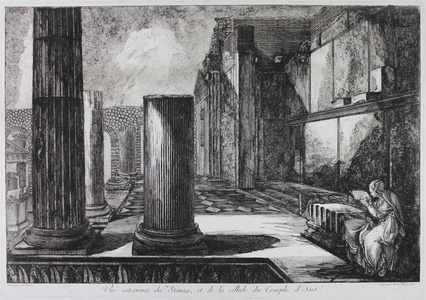| Method | Etching |
| Artist | Francesco Piranesi |
| Published | Dessine par J.B. Piranesi. Grave par F. Piranesi L'an 13. (1805. |
| Dimensions | Image 480 x 718 mm, Plate 510 x 732 mm, Sheet 590 x 835 mm |
| Notes |
A view of the interior of the Pronaos and Cella of the Temple of Isis at Pompeii, Plate 67 from Volume 2 of Francesco Piranesi's Antiquites de Pompeia, part of his Antiquités de la Grande Grèce. The scene is an unusual pastiche of ancient and modern. The building is shown in ruins, as it appeared at the time of Piranesi's visits to the city in the 1770s, but a figure to the right of the foreground is from the Roman era, a hooded figure consulting a writing tablet, perhaps intended to represent a priestess. Unusually, the building is featured in cutaway, with the walls of the cella removed at the right side and the building shown as more ruinous that it really was in order to show the viewer the interior of the temple. The figure sits on a ledge by one of the pilasters that is actually the base of one of the temple's two flanking exterior niches. The date of the plate, in the inscription space, is given in both the Revolutionary and Gregorian calendars. The Antiquités de la Grande Grèce was published in the early years of the nineteenth century, but was most likely inspired by two visits to Paestum, Pompeii, and Herculaneum undertaken by Francesco Piranesi with his father in 1770 and 1778. Giovanni Battista Piranesi had prepared a number of preparatory sketches of the temples of Pompeii and Paestum that were eventually engraved and published by Francesco, but the remaining plates for the three volumes of the Antiquités seem to have been of Francesco's invention. Although lacking some of the romanticism of his father's earlier plates of Rome, the illustrations from the Antiquités nevertheless provide a valuable record of progress in the archaeological exploration of the sites of the Neapolitan region, and are testament to Francesco's deep engagement with Roman antiquity. Francesco Piranesi (c.1756-1810) was an Italian engraver, etcher and architect who mainly worked in Paris. He was the eldest son of the famous etcher Giovanni Battista Piranesi (1720-1778), under whom he studied printmaking and architecture. By 1775, Piranesi was both producing his own work and assisting with his father's. Upon the death of Giovanni Piranesi three years later, he inherited his father's publishing house and was responsible for producing most of the later editions of his prints. In 1798, Piranesi moved to Paris, where he was later employed by Napolean, to engrave classical sculpture and vase collections within France and French-occupied Italy. He also collaborated with the French artist Louis-Jean Desprez (c.1743-1804) on a series of Italian views which were sold at Piranesi's shop in Rome. Although the 1783 advertisement for the series promised forty-eight views, the series was not completed before Desprez left Rome to become Director of Scenic Decorations at the Stockholm Opera. Piranesi died in Paris from syphilis in 1810. Condition: Strong dark impression with full margins. Marginal creasing and ink-staining. Some repaired paper splitting to platemarks. |
| Framing | unmounted |
| Price | £700.00 |
| Stock ID | 50728 |

